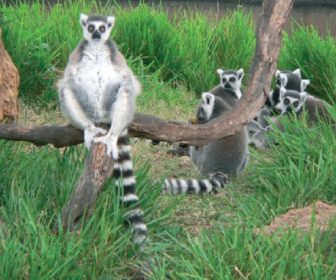Extant lemurs inhabit the island of Madagascar along with other prosimians, the indriids and the aye-aye. Among the former are the “mouse” lemurs (cheirogaleids); the “sportive”lemurs (genus Lepilemur); the “gentle,” “wooly,” and “bamboo” lemurs (genus Hapalemur); varecias (genus Varecia); the ring-tailed lemur (genus Lemur); and various other lemurs such as black, brown, collared, macaco, and mongoose lemurs (genus Eulemur). As prosimians, all lemurs possess a grooming claw on the second pedal digit, and their six lower anterior teeth (with the central four being more slender than the lateral pair) form a variably elongate and procumbent toothcomb. Lepilemur is unique among primates in that it does not replace its upper deciduous incisors; the anterior region of the palate bears a keratinized cud pad. Mouse lemurs have somewhat elongate ankle or tarsal bones (primarily the calcaneus) and locomote by leaping between more or less vertical branches. The other lemurs are hindlimb-dominated quadrupedalists that are equally agile on the ground and in the trees.
 Most lemurs are diurnal, but mouse lemurs and Lepilemur are nocturnal. Mouse lemurs are insectivorous and display a “noyen” type of social behavior (i.e., females share a nest and territory that is overlapped by the territories of single males); they enter a state of metabolic slowdown or torpor while asleep. Male and female Lepilemur urine and feces mark the boundaries of their overlapping territories. Lepilemur is the only prosimian whose diet consists solely of mature leaves and that reingests its feces (caecotrophy) as a way of further processing its food intake. Other lemurs aggregate in variably sized groups of males and females and, depending on the species, are folivorous (leaf eating) and frugivorous (fruit eating) to varying degrees. Lemur and Eulemur scent mark territory with urine, feces, and glands (variably located on the wrists, neck, and/or forehead). Lemur is distinguished from Eulemur species in that it spends more time on the ground and its social behavior is based on a hierarchical arrangement of female dominance. The activity pattern of at least some Eulemur is cathemeral (i.e., sporadic throughout a 24-hour period), rather than diurnal or crepuscular, although under certain circumstances the same group of Eulemur may temporarily become nocturnal (and change their diet to nectar and pollen). Hapalemurs ability to digest toxic bamboo shoots has allowed it to spread its range as bamboo replaces areas of primary forest that were lost to deforestation.
Most lemurs are diurnal, but mouse lemurs and Lepilemur are nocturnal. Mouse lemurs are insectivorous and display a “noyen” type of social behavior (i.e., females share a nest and territory that is overlapped by the territories of single males); they enter a state of metabolic slowdown or torpor while asleep. Male and female Lepilemur urine and feces mark the boundaries of their overlapping territories. Lepilemur is the only prosimian whose diet consists solely of mature leaves and that reingests its feces (caecotrophy) as a way of further processing its food intake. Other lemurs aggregate in variably sized groups of males and females and, depending on the species, are folivorous (leaf eating) and frugivorous (fruit eating) to varying degrees. Lemur and Eulemur scent mark territory with urine, feces, and glands (variably located on the wrists, neck, and/or forehead). Lemur is distinguished from Eulemur species in that it spends more time on the ground and its social behavior is based on a hierarchical arrangement of female dominance. The activity pattern of at least some Eulemur is cathemeral (i.e., sporadic throughout a 24-hour period), rather than diurnal or crepuscular, although under certain circumstances the same group of Eulemur may temporarily become nocturnal (and change their diet to nectar and pollen). Hapalemurs ability to digest toxic bamboo shoots has allowed it to spread its range as bamboo replaces areas of primary forest that were lost to deforestation.
 The systematics, phylogenetic relationships, and biogeographic history of extant lemurs are not without debate. Although a simple hypothesis is that primate diversity on Madagascar emerged after the chance invasion of a single ancestor (a historically favored scenario, most recently embraced by molecular anthropologists), comparative morphological studies suggest that mouse lemurs may be more closely related to a loris-bushbaby group (for example, by virtue of a unique arterial pattern involving the carotid artery) than to any Malagasy group. In addition to alternative theories of indriid-adapid relationships, there is a case for multiple invasions of Madagascar. Among the nonmouse lemurs, Lemur has been united with Hapalemur (due to the presence of wrist glands and the interpretations of some chromosomal studies), although detailed craniodental analyses indicate closer relationships between Lemur and Eulemur and between Lepilemur and Hapalemur.
The systematics, phylogenetic relationships, and biogeographic history of extant lemurs are not without debate. Although a simple hypothesis is that primate diversity on Madagascar emerged after the chance invasion of a single ancestor (a historically favored scenario, most recently embraced by molecular anthropologists), comparative morphological studies suggest that mouse lemurs may be more closely related to a loris-bushbaby group (for example, by virtue of a unique arterial pattern involving the carotid artery) than to any Malagasy group. In addition to alternative theories of indriid-adapid relationships, there is a case for multiple invasions of Madagascar. Among the nonmouse lemurs, Lemur has been united with Hapalemur (due to the presence of wrist glands and the interpretations of some chromosomal studies), although detailed craniodental analyses indicate closer relationships between Lemur and Eulemur and between Lepilemur and Hapalemur.
References:
- Delson, E., Tattersall, I., Van Couvering, J., & Brooks, A. S. (Eds.). (2000). Encyclopedia of human evolution and prehistory (2nd ed.). New York: Garland.
- Fleagle, J. G. (1999). Primate adaptation and evolution (2nd ed.). San Diego: Academic Press.
- Tattersall, I. (1982). The primates of Madagascar. New York: Columbia University Press.

